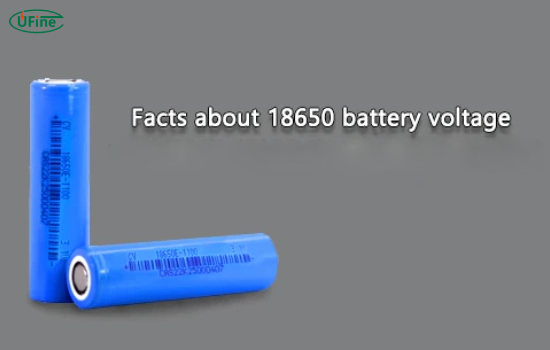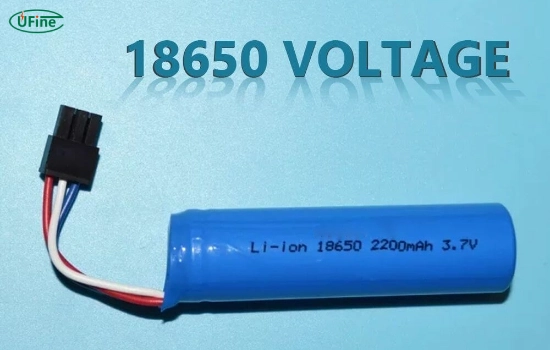18650 Battery Voltage plays a pivotal role in the performance and longevity of these powerhouses. Understanding the nuances of voltage in 18650 batteries is crucial for maximizing their efficiency and lifespan. In this article, we delve deep into the specifics of 18650 Battery Voltage, shedding light on its nominal values, factors impacting voltage fluctuations, charging and discharging intricacies, and addressing common FAQs surrounding this critical aspect.
Part 1. Nominal voltage of 18650 batteries
3.2V 18650 Batteries Voltage
Batteries labeled with a nominal voltage of 3.2V typically utilize lithium iron phosphate (LiFePO4) chemistry. This chemistry inherently offers a lower voltage output compared to other lithium-ion variants. The choice of LiFePO4 chemistry prioritizes safety and stability over high energy density, making these batteries ideal for applications requiring lower voltage thresholds and enhanced safety features.
3.6V and 3.7V 18650 Batteries Voltage
These batteries predominantly utilize lithium-ion chemistry with varying compositions, allowing a nominal voltage range of 3.6V to 3.7V. The specific blend of materials and electrode configurations within these batteries contributes to the moderate voltage output. This range balances energy density, capacity, and voltage output, catering to various applications, from portable electronics to power tools.
4.2V 18650 Batteries Voltage
Batteries designated with a nominal voltage of 4.2V generally employ lithium-ion chemistry, often incorporating materials and designs optimized for higher voltage thresholds. This variant uses different electrode coatings or additives, allowing the battery to reach a higher voltage during the charging process. While offering increased energy density and power output, these batteries might exhibit a shorter lifespan due to the stress-induced during charging and discharging cycles.
18650 Battery 4.2V VS 3.7V: What is Different?
Part 2. What factors can affect the 18650 battery voltage?
Numerous factors intricately impact the voltage stability of 18650 batteries, influencing their overall performance and longevity.
Temperature Extremes
Temperature fluctuations, both high and low, significantly impact battery voltage.
- High Temperatures: Accelerate chemical reactions, potentially increasing voltage temporarily due to reduced internal resistance.
- Low Temperatures: Reduce voltage temporarily, impeding chemical reactions within the battery, resulting in lower voltage output.
Charging and Discharging Patterns
The charging and discharging behavior directly influences voltage stability.
- Overcharging: Can elevate voltage beyond safe levels, impacting battery health and potentially causing voltage irregularities.
- Deep Discharges: Repeated deep discharges can lead to voltage sag, reducing the battery’s overall capacity and nominal voltage.
Load Characteristics
The applied load and discharge rate can significantly affect voltage stability.
- High-Drain Devices: Such devices draw more current, causing voltage fluctuations during use due to increased internal resistance.
- Varied Load Profiles: Rapid changes in load can lead to temporary voltage drops or spikes.
Battery Age and Usage
The age of the battery and its usage patterns impact voltage stability.
- Cycle Life: As batteries undergo charge-discharge cycles, nominal voltage might decrease, affecting overall performance.
- Storage Conditions: Prolonged storage or irregular usage can lead to capacity loss and voltage fluctuations.
Manufacturing Quality
Differences in manufacturing quality can influence voltage stability among batteries.
- Electrode Consistency: Variations in electrode material and assembly processes can lead to deviations in nominal voltage.
- Quality Control: Stringent manufacturing standards ensure consistent voltage output across batches.
Part 3. 18650 Battery charging and discharging voltage
Understanding the precise voltage thresholds during both the charging and discharging phases is critical for optimizing the performance and lifespan of 18650 batteries.
1. Charging Voltage Specifications
- Maximum Charging Voltage: The maximum charging voltage for most 18650 batteries is around 4.2 volts. This voltage level marks the completion of the charging process and should not be exceeded to prevent overcharging.
- Constant Voltage Stage: Once the battery reaches total capacity, the charger transitions to a stable voltage stage, maintaining a steady 4.2 volts to ensure a complete charge while safeguarding against overcharging.
2. Discharging Voltage Specifications
- Minimum Discharge Voltage: 18650 batteries typically discharge to approximately 2.5 to 3.0 volts during normal usage. Releasing below this threshold can lead to over-discharge and potential damage to the battery.
- Voltage Stability Under Load: When the battery is in use, especially in high-demand scenarios, temporary voltage drops might occur. Managing these fluctuations within safe limits is essential to maintain the battery’s health and performance.
3. Voltage Thresholds and Battery Longevity
- Impact of Exceeding Voltage Limits: Overcharging beyond 4.2 volts or over-discharging below 2.5 volts can significantly affect the battery’s lifespan, reducing its capacity and overall performance over time.
- Optimal Voltage Range: Keeping the battery within the recommended voltage range during charging and discharging cycles helps ensure a longer lifespan and consistent performance.
4. Importance of Voltage Monitoring
- Utilizing Voltage Monitoring Tools: Chargers equipped with voltage monitoring capabilities or dedicated voltage meters enable precise tracking of the battery’s voltage levels.
- Preventing Damage: Monitoring voltage fluctuations during charging and discharging helps prevent overcharging, over-discharging, and subsequent damage to the battery cells.
5. Adapting Voltage for Specific Applications
- Device-Specific Voltage Needs: Different devices have varying voltage requirements. The correct 18650 battery with the appropriate voltage range is crucial for optimal performance and compatibility.
- Considerations for High-Drain Devices: High-drain devices, such as power tools or high-performance flashlights, often require batteries with higher nominal voltages to sustain consistent performance under heavy loads.
Part 4. FAQs
-
What is the voltage of a fully charged 18650 battery?
A fully charged 18650 battery typically reaches around 4.2 volts. This voltage may vary between different lithium-ion chemistries or specific battery models. -
What voltage is needed to charge the 18650 battery?
Generally, charging an 18650 battery involves applying a voltage slightly higher than its nominal voltage, usually around 4.2 volts. However, precise charging voltages might differ based on the specific manufacturer’s recommendations or the battery’s chemistry. -
Are all 18650 batteries the same voltage?
Not all 18650 batteries have the same voltage. While most lithium-ion 18650 batteries have a nominal voltage of 3.7 volts, their fully charged voltage can range from 4.2 to 4.35 volts based on the specific battery chemistry. -
Can I use a 3.7 V battery instead of 4.2 V?
Using a 3.7-volt 18650 battery instead of a 4.2-volt battery might result in lower capacity or runtime. Matching the battery voltage to the device’s requirements is essential to ensure proper functionality and performance. -
How do I know if my 18650 battery could be better?
Signs of a bad 18650 battery include reduced capacity, shorter runtime, increased heat during charging or discharging, physical damage, or if it fails to hold a charge effectively. Testing with a multimeter or specialized battery tester can also reveal its health.
Related Tags:
More Articles

LiPo Battery Discharge Rate Guide & Calculation Tips
Understand LiPo battery discharge rates, C-ratings, and how to calculate max current. Essential guide for RC, drones, and electronics users.
High‑Capacity 3S LiPo Batteries: 5000 mAh vs. 10000 mAh
Compare 3S LiPo 5000mAh vs 10000mAh batteries by weight, power, and use. Find the best fit for your drone, RC car, or boat setup.
Top 5 Applications for Small 3S LiPo Batteries
Small 3S LiPo batteries power drones, RC gear, wearables, and robotics with high energy and low weight. Making them ideal for compact electronics projects.
Building and Charging Your Own 3S LiPo Pack: A Step‑by‑Step Guide
Learn how to build, balance, and charge a 3S LiPo battery pack safely at home with this complete DIY guide for hobbyists and beginners.
How to Choose the Right LiPo Battery Plug Type?
Discover the best LiPo battery plug types, how to choose them, and expert tips for safe usage, soldering, and maintenance.





